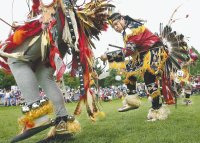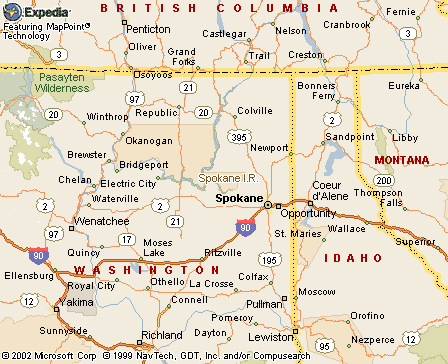|
|
Canku Ota |
|
|
(Many Paths) |
||
|
An Online Newsletter Celebrating Native America |
||
|
September 7, 2002 - Issue 69 |
||
|
|
||
|
Cultural Footprints |
||
|
credits: Dan Pelle
- The Spokesman-Review
Paul Melting-Tallow, 43, of Spokane performs during the prairie chicken dance competition Saturday at the Spokane Falls Northwest Indian Encampment and Pow Wow at Riverfront Park. |
 "It's
so, wow" "It's
so, wow"
The 60-year-old Blackfeet Indian was taught the dance "as a knee-high" in Browning, Mont. It'd fallen so out of favor that Blackwater, a resident of Lethbridge, Alberta, remembers being the only one dancing it at regional powwows for years. The prairie chicken is back. Twenty-one men did the dance -- strutting, pecking and bobbing in imitation of the grassland birds -- at Saturday's Spokane Falls Northwest Indian Encampment and Pow Wow. "It's back strong," said Blackwater, an honored elder who carried the Canadian flag at the Grand Entry dance. "It's the money that brought it back." Blackwater is among the dancers who travel a circuit of regional powwows competing for prize money. Winners at Spokane's powwow get $500. The dance is believed to have originated in Oklahoma and drifted west. While happy there are younger prairie chicken dancers, Blackwater grumbled about their style. "You have to put a hell of style into it," he said. "The younger ones have some rock and roll." Competitors are judged as much on their footwork as their regalia. Prairie chicken dancers wore porcupine quill headdresses -- called a roach -- and a bustle of eagle feathers, and distinguished themselves with colorful undergarments. That color contributed to a feast for the senses at the powwow in Riverfront Park's Lilac Bowl. Hundreds of tents ringed the bowl. A war bonnet sat on the trunk of dancer Willie Auger's battered white Volvo. Fry bread wetted paper plates with grease. Twenty-one drumming groups pounded as women wove through the crowd with skirts festooned with bells. "It's so, wow," said Gretchen Schroeder, an overwhelmed German tourist staying at a downtown Spokane hotel. She happened on the powwow during a park walk. "I cannot believe I'm seeing your cultural history in such a way," she said, eating an Indian taco. Park officials expected about 3,000 visitors Saturday and today, although powwow organizers feared the Franklin Graham Festival would pull away some spectators. Among the stalls hawking food, jewelry and clothing was a small exhibit on Native American history. It noted that the U.S. Indian population shrank from an estimated 5 million at Columbus' landing to 237,000 in 1900, then rebounded to 2.4 million in 2000. Wayne Smartlowit, a Yakama tribal member from Toppenish, took his family to the Spokane powwow in hopes of encouraging his kids to learn tradition. He danced the slower traditional dance, while his twin 6-year-old boys, Kyle and Kurtis, danced the grass dance. "I do it for a lot of reasons, spiritual reasons," he said. "I want my younger ones to follow the traditions, to know what road to go on when I'm gone." Blackwater, as he prepared for the afternoon dance, took care in unrolling his elegant roach headdress from an elastic athletic wrap. Getting his two huge eagle feather bustles through the U.S. border crossing can be tough, he said. "Customs can raise hell about the feather," he said. "They ask where you got the feathers, look at them." The prairie chicken competition includes four separate dances -- more than a half hour of continuous ducking, shaking and pounding moccasins. Blackwater sauntered off winded. He had to give way to another competition of younger chicken dancers. "We lost it for a while," he said. "Now we've got it back."
|
|
|
||
|
|
||
| Canku Ota is a free Newsletter celebrating Native America, its traditions and accomplishments . We do not provide subscriber or visitor names to anyone. Some articles presented in Canku Ota may contain copyright material. We have received appropriate permissions for republishing any articles. Material appearing here is distributed without profit or monetary gain to those who have expressed an interest. This is in accordance with Title 17 U.S.C. section 107. | ||
|
Canku Ota is a copyright © 2000, 2001, 2002 of Vicki Lockard and Paul Barry. |
||
 |
 |
|
|
The "Canku Ota - A Newsletter Celebrating Native America" web site and its design is the |
||
|
Copyright © 1999, 2000, 2001, 2002 of Paul C. Barry. |
||
|
All Rights Reserved. |
||
